snowstorm aftermath: pruning, prayers, goodbyes
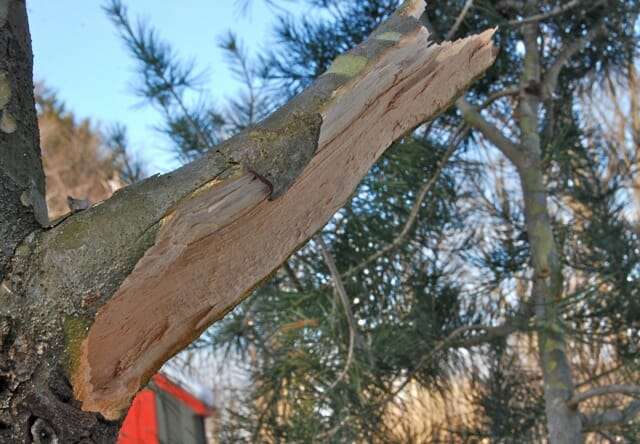
As I told reader Lynn the other day, when she commented about her own snow-damaged landscape, I start working while it’s snowing. During the storm at several junctures, I gently knock heavy loads off some vulnerable evergreens, especially, to prevent buildup. I always use a broom where I can reach, and make my movements in upward strokes (not pulling downward, which further adds to the weight and can split the wood, especially in brittle pines, for instance).
I never mess with ice-encrusted branches; too vulnerable.
On taller specimens, I use a 10-foot piece of quarter-round molding (above) from the lumber store—my secret weapon, left over from a home improvement a decade ago. It’s about an inch thick, and the trick is it’s sturdy yet flexible, so I can weave it up into the higher branches and sort of wiggle it around slowly (in a small lasso motion) without inflicting damage that a heavier pole might.
Once the snow stops, I work at once to prevent further problems by making clean pruning cuts to remove anything that’s half-hanging or damaged and dangling. Particularly if these injured parts are weighing down a bigger branch or might peel off more bark by whipping in the wind, I drop them to the ground with a saw or lopper.
On a kousa dogwood by the front walk, for instance, two substantial side shoots off major branches were partly severed, so I reduced the load to try to save the main branches they emanated from.
I only had 12 inches of snow, but its weight destroyed numerous trees and shrubs. The accident-prone lacebark pine I’ve written about before, the one I was wondering out loud about, is no longer in the “wondering about” column. Five or six more branches of poor Pinus bungeana are now gone (top photo and just above), and what I have is a 15-foot-tall lollypop with gouges in the naked trunk. Come spring, I will just have a memory.
Three Daphne x burkwoodii ‘Carol Mackie,’ including a big old one in a prominent spot, are now D. prostrata instead (if you get my botanical Latin joke), flattened into octopus shapes on the ground. Goners (see before and after photos, below and above).
I did not try to dig out buried woodies like this, as I could have done more damage (they were completely hidden beneath the snow). I just waited to see as things melt whether the branches were cracked, and they are. Farewell.
Now, as the snow continues to recede and light and warmth gradually increase, various things are gradually righting themselves—especially the conifers. Letting them take their time is preferable to forcibly repositioning anything.
Others won’t bounce back, and in another couple of weeks, I may start offering some tangible support in the form of stakes, and maybe even have to choose a new leader—training a likely shoot upward with twine and a bamboo cane—for survivors that are now without one.
First there will be lots of corrective pruning, including some things that will go right to the ground in hopes of rising again, rejuvenated. I just can’t tell which ones yet, or count the losses—and so I sit and wait a little while longer, trying to be patient. Isn’t that the virtue they say we gardeners had better have a bushel of?



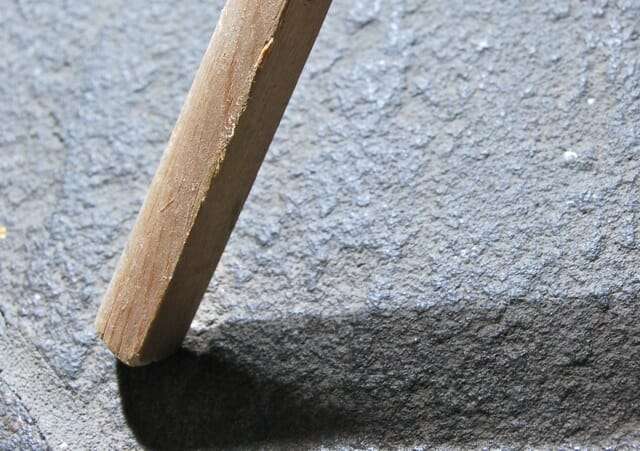
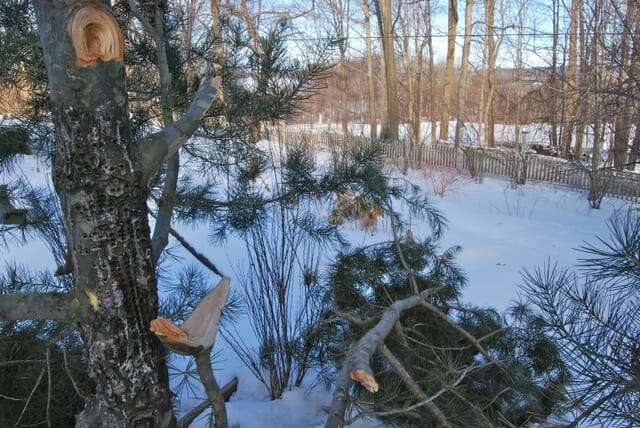
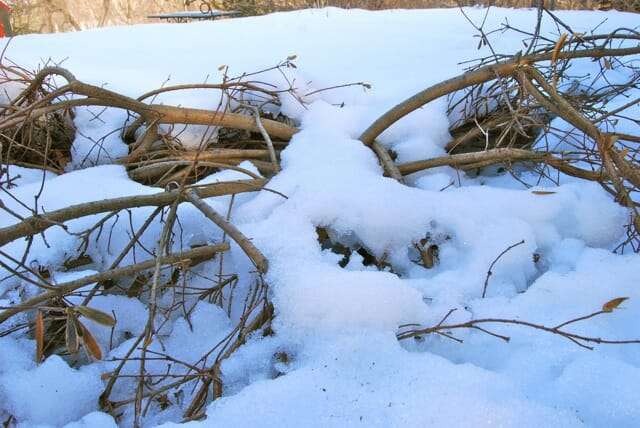
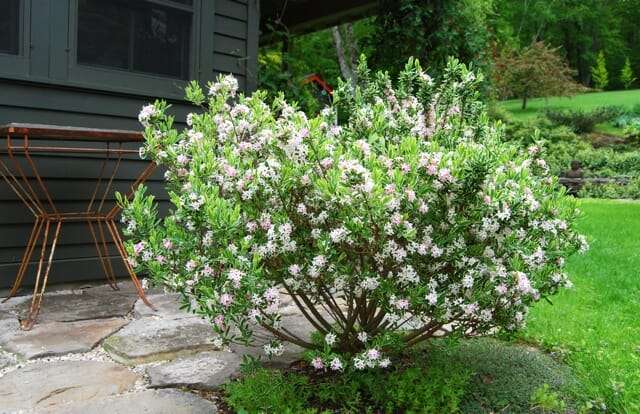


Here’s a snow/ice damage tip that has worked for me about 75% of the time:
The previous two winters in southern Maine had created a heavy snow/ice combination load on woody shrubs causing many to split down the middle. i have saved Rhododendrons, Daphnes, small Japanese Maples, and dwarf Conifers by screwing the split parts back together with stainless steel screws. First hold the parts together as tightly as possible and drill a pilot hole (to prevent splitting) before attaching the screw. Over the two years that some repairs were made, some halves didn’t knit properly but many more did. In most cases you would not know that a repair was made unless you looked carefully. In some cases the bark has already covered the screw.
Welcome, Bob. Carpentry in the garden! Love it. A fascinating solution, even if as you say it solves even a portion of the otherwise-goner situations. Hardware store, here I come. (I don’t have any stainless screws in stock here, as my standard “fix anything” item is the drywall type.) Thanks for the idea, and see you soon again, I hope.
Thank You so much for this POST!
We got hammered with 4ft. of wet snow in Cornwallville last week and our ancient lilacs were hit bad. I felt a little lost and helpless about what to do with all the damaged shrubs.
I dug them out as best I could and now hopefully this weekend I can prune off all the cracked branches. And if there “goners” I guess that’s just the way it is…….
That is just terrible. How does it compare to prior years, as far as damage goes? Does your climate normally require so much repair work come spring? Growing up all my life in Southern California I can’t imagine not gardening year round and possibly coming back in the spring missing a good chunk of my stock. Best of luck.
Re screwing Daphnes back together: A large multistem shrub like Margaret’s may be too hard to do. If many of the stems have damage it may be too tedious a job and not worth the effort. If the stems emanate from a central trunk that is split (like mine) the repair is doable. Daphnes, of course, often die for inexplicable reasons at any stage of their lives.
Do tell us Margaret if you’re able to save that poor Daphne with screws, like Bob suggested. In my experience, the smallest wound or even remedial pruning results in inevitable Daphne death! I’d be really interested to know if you are successful.
Thanks for the explanation and caveat Bob. My Daphne died after being the so-called ‘maypole’ for our orphaned baby squirrel. His spazzy fits at its base resulted in branch breakage and slow, painful death…of the Daphne that is. The squirrel went on to lead a happy, healthy wild life. ;c)
Margaret so sorry to see such damage in your garden from the winter. My area escaped it this year, but 2009 we were hit with two ice storms that did do major damage each time. So we were needing a break.
LOVE your new website format! Really people, is this not one of the best laid out websites ever? Great work.
And thanks Bob Scherer for that great tip on trying to save storm damaged specimens. Making a mental note now.
Screws – great idea! I have tried other triage, like tape and twine. Worked very well, especially on lilac. Bob is like a modern day orthopedic surgeon – with the screws and the plates! If it works for we mere mortals, why not give a well loved shrub the same help!!
Found a very large tree on our property had come down – right on the dog fence and split a metal pole in two! I, too, thought, I had been fortunate in that last heavy storm. I think it was the wind after the storm that did in this tree! But off to play on this sunny day – the garden is waking – the hellebores are blooming! Enjoy!
Condolences from just slightly to the south, where we took similar losses, after having taken what we could of similar precautions – I use a 12 foot telescoping pruner where you use the 1-by; light, flexible and long (or not, as needed).
Lovin’ the screws!! Look forward to trying it, currently between daphnes but there are other things.
Biggest sorrows a large graceful old apple no longer either, and a v. tall arborvitae that’s probably going to be history but I keep hoping against hope.
definition of gardening, as you say. (Starting huge assortment of tomatoes, for instance, praying the angels of blight will pass over this year).
Made a mental note of the emergency first-aid (rod + screws). My sympathies to those who are grieving the loss of a loved one. Meanwhile, time to think of a replacement and care for the survivors!!
Margaret,
I have been enjoying your blog for about a year now. I was sorry to see all the damage you just experienced. Thanks for the tip about using a 10 ft length of quarter round molding. I am going to give it a try next storm–hopefully not any time soon!
Looking forward to spring.
Welcome, Michael. My “secret weapon” was the result of improvisation years ago — it was the only long enough thing here, during a really bad storm. But I have come to rely on this recycled bit, and it has served me well. I am glad you have now said a proper hello and hope it will be the first of many utterances. And yes, let’s hope there are no more heavy storms for quite some time, shall we? :)
It’s been a tough weekend for patience with the sun out and all its promise.
Repairs with screw, what a good idea! Thank you for the information!
what a miserable ten days of counting the losses down here in southern westchester county in ny! i lost a 50 year-old r. maximum that had a wonderful monstrous shape – perhaps a little too monstrous. now, no more. i also lost a 40 year old chinese juniper that was about 18 feet high. again, another lesson that gentle, steady pruning is better than neglectful procrastination. at least i don’t feel responsible for the dozens of white pines that dropped branches like lemmings going over the edge. still, a very sad week indeed.
@Phil: Oh, dear, so sorry. Lemmings everywhere here, too, with the pines — the more I drive around, the more I see of that. But sounds like you lost some real sculpture, and I am so sorry. My sympathies.
I love the site! I look forward to every posting and have shared with many.
It is the BEST gardening blog in the NE.
Thanks for taking the time and sharing the good, the bad and the ugly!
I just know Margaret that Frog Boys jumped for Joy at the news of their Aussie cousin’s being alive and well after 30 years of believing them extinct! The find of 100+ yellow-spotted bell frog allowed their minister of environment to be so happy that future generations would be able to enjoy the noise and color, after finding them on rural farm land!
I want to thank you for keeping NY Frog boys so happy and healthy! fir many to enjoy!
G
Welcome Gloria, and thank you for all the kind words. I see a little action out on the frogpond — a snout or two poking up for a second — and soon the boys (and girls) will be back above the surface, thankfully. I have missed them. See you soon again, too, I hope.
I rarely get accused of looking at the world through rose-colored glasses, but don’t write snow/ice damage off as damage automatically. It opens new opportunities. We got clobbered and my yard still looks like a tornado hit, but on closer inspection I’m guardedly happy with how things got pruned. For example, I’ve got a Japanese maple that looked like a great ottoman–rather boring, actually. The weaker interior branches snapped due to the ice and opened it up like a chalice. More sunlight will reach previously shady spots, stimulating growth. No longer will I have a great leafy ottoman looming in the side yard, but a tree with character.
S
What a wonderful website; as Gloria claimed, the best gardening blog in the NE!
I share in everyone’s pain caused by Mother Nature this winter. Pins, Rods, Splints and Shunts – hopefully our amatuer surgeon skills work in saving the young and old alike. Cheers to the budding miracles of life and the promise of Spring. ‘Welcome Home Sunshine’ …it’s time to put on the mud boots and gloves and let’s start raking and hoeing and digging!
Welcome, Karen. You are sweet to offer praise, thank you. ‘Amateur surgeon skills’ it is, you are right…and onward we go, into another season. I am excited at the prospects, even with the losses and injured to cope with first. See you soon.
@Steve: Loss of plant=room for new plant. I agree. When do we go shopping? :)
We also lost some very old lilacs to the heavy snow. Happily the old Quince will have even more room to expand this space.
Welcome, Rae. I am so sorry to hear about your lilacs. If they are not cracked they may stand upright in time, but many were cracked right through and need rejuvenating near here, too. I have seen many victims along my travels the last two weeks or so. Lilac pruning basics are here, plus some good links. See you soon!
I have six beautiful 5 year old daphnes “Carol Mackie” that have been trashed/flattened by a heavy Colorado May snowstorm that has them lying flat, they do not appear broken and are in full bloom. They look like they might benefit from a collar like a wide tomato cage going forward, has anyone ever tried anything like that. I definitley get the “prostata humor. I hate to lose these plants. Late snow is always a problem and this is not the first time it happened but it is the worst
Welcome, Eleanor. Here’s the good news: Just let them be,and I predict they will rescurrect. Mine did over about a month’s time. Amazing, but true. So I’d be careful not to budge them myself but to let them have their way for awile and rebound as best they can under their own steam. Propping may be needed later, but wait and see for now – always the advice with snow-damaged woody things. Wait and see first.
An update on my screw repair tip at the top of the comments. After another year there have been a couple of failures to my previous attempts. Still – I have some permanent (I think) successes. A dwarf Korean Fir (Abies koreana ‘Starker’s Dwarf’), two Rhododendron Yakushimanum hybrids, and a dwarf Japanese Maple (Acer palmatum ‘Kiyohime’). The two Yaku rhodies & the Korean Fir definitely would have been goners without the repair. The failures were to plants that were too small to compartmentalize the inevitable damage surrounding the screws. So – if the split sections are thick enough and can be knit together without misalignment, the repair will likely be successful. Certainly worth a try.